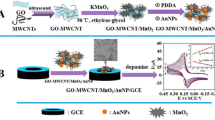Abstract
A comparative study about the electrochemical response of glassy carbon electrode modified with four different carbon nanomaterial (CNM) against dsDNA is reported. The CNM used were oxidized and nonoxidized multiwalled carbon nanotubes (MWNT-OX and MWNT, respectively), graphene oxide (GO) and chemically reduced graphene oxide (RGO) and dispersed in 3:1 chitosan/water mixture. The electrodes were characterized by cyclic voltammetry, scanning electrochemical microscopy, and contact angle measurements. The results showed that the type and degree of oxidation have a strong effect on the electroactivity of the modified electrode. GCE/RGO clearly exhibited the most electroactive surface among the CNMs, demonstrating that the graphitic structure is highly important. A more sensitive electrochemical response against dsDNA was obtained when GCE/RGO electrode was used. Therefore, RGO is the CNM recommended for further consideration in the development of DNA biosensors.





Similar content being viewed by others
References
Primo E, Gutierrez F, Luque G, Dalmasso P, Gasnier A, Jalit Y, Moreno M, Bracamonte M, Eguilaz-Rubio M, Pedano M, Rodríguez M, Ferreyra N, Rubianes M, Bollo S, Rivas G (2013) Comparative study of the electrochemical behavior and analytical applications of (bio)sensing platforms based on the use of multi-walled carbon nanotubes dispersed in different polymers. Anal Chim Acta 805:19–35
Ambrosi A, Chua CK, Bonanni A, Pumera M (2014) Electrochemistry of Graphene and Related Materials. Chem Rev 14:7150–7188
Musameh M, Wang J, Merkoci A, Lin Y (2002) Low-potential stable NADH detection at carbon-nanotube-modified glassy carbon electrodes. Electrochem Commun 4:743–746
Sotiropoulou S, Gavalas V, Vamvakaki V, Chaniotakis NA (2003) Novel carbon materials in biosensor systems. Biosens Bioelectron 18:211–215
Lin CW, Wei CC, Liao SS, Huang CY, Sun CL, Wu PJ, Lu YJ, Yang HW, Ma CCM (2015) A reusable magnetic graphene oxide-modified biosensor for vascular endothelial growth factor detection in cancer diagnosis. Biosens Bioelectron 67:431–437
Kumar S, Ahlawat W, Kumar R, Dilbaghi N (2015) Graphene, carbon nanotubes, zinc oxide and gold as elite nanomaterials for fabrication of biosensors for healthcare. Biosens Bioelectron 70:498–503
Kuila T, Bose, Mishra AK, Khanra P, Kim NH, Lee JH (2012) Chemical functionalization of graphene and its applications. Prog Mater Sci 57:1061–1105
Yang W, Ratinac KR, Ringer SP, Thordarson P, Gooding JJ, Braet F (2010) Carbon nanomaterials in biosensors: should you use nanotubes or graphene? Angew Chem Int Ed 49:2114–2138
Chen Y, Vedala H, Kotchey GP, Audfray A, Cecioni S, Imberty A, Vidal S, Star A (2012) Electronic detection of lectins using carbohydrate-functionalized nanostructures: graphene versus carbon nanotubes. ACS Nano 6:760–770
Zheng D, Vashist SK, Dykas MM, Saha S, Al-Rubeaan K, Lam E, Luong JHT, Sheu FS (2013) Graphene versus multi-walled carbon nanotubes for electrochemical glucose biosensing. Materials 6:1011–1027
Bollo S, Ferreyra NF, Rivas GA (2007) Electrooxidation of DNA at glassy carbon electrodes modified with multi-wall carbon nanotubes dispersed in chitosan. Electroanalytical 19:833–840
Arias P, Ferreyra NF, Rivas GA, Bollo S (2009) Glassy carbon electrodes modified with CNT dispersed in chitosan: analytical applications for sensing DNA- methylene blue interaction. J Electroanal Chem 634:123–126
Cañete-Rosales P, Ortega V, Álvarez-Lueje A, Bollo S, Gonzalez M, Ansón A, Martínez MT (2012) Influence of size and oxidative treatments of multi-walled carbon nanotubes on their electrocatalytic properties. Electrochim Acta 62:163–171
Cañete-Rosales P, Álvarez-Lueje A, Bollo S (2014) Electrooxidation of DNA at glassy carbon electrodes modified with multi-walled carbon nanotubes with different oxidation degree. J Chil Chem Soc 49:2494–2497
Cañete-Rosales P, Álvarez-Lueje A, Bollo S (2014) Ethylendiamine-functionalized multi-walled carbon nanotubes prevent cationic dispersant use in the electrochemical detection of DNA. Sensor Actuators B Chem 191:688–694
Buglione L, Pumera M (2012) Graphene/carbon nanotube composites not exhibiting synergic effect for supercapacitors: The resulting capacitance being average of capacitance of individual components. Electrochem Commun 14:5–8
Li J, Cassell A, Delzeit L, Han J, Meyyappan M (2002) Novel three-dimensional electrodes: electrochemical properties of carbon nanotube ensembles. J Phys Chem B 106:9299–9305
Li H, Luo JY, Zhou XF, Yu CZ, Xia YY (2007) An ordered mesoporous carbon with short pore length and its electrochemical performances in supercapacitor applications. J Electrochem Soc 154:A731–A736
González-Segura K, Cañete-Rosales P, del Rio R, Yáñez C, Ferreyra NF, Rivas GA, Bollo S (2012) Effect of the dispersing agent on the electrochemical response of glassy carbon electrodes modified with dispersions of carbon nanotubes. Electroanalytical 24:2317–2323
Acknowledgments
Financial support from the National Fund for Scientific and Technological Development-CHILE FONDECYT No. 1120246 (80 %) and FONDAP No. 15130011 (20 %) is gratefully acknowledged. D.F.B. acknowledges Chile’s National Commission for Scientific and Technological Research (CONICYT) scholarships for her PhD studies in Chile.
Author information
Authors and Affiliations
Corresponding author
Rights and permissions
About this article
Cite this article
Báez, D.F., Bollo, S. A comparative study of electrochemical performances of carbon nanomaterial-modified electrodes for DNA detection. Nanotubes or graphene?. J Solid State Electrochem 20, 1059–1064 (2016). https://doi.org/10.1007/s10008-015-2997-2
Received:
Revised:
Accepted:
Published:
Issue Date:
DOI: https://doi.org/10.1007/s10008-015-2997-2




